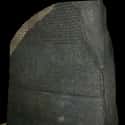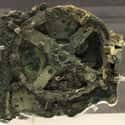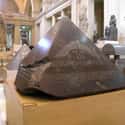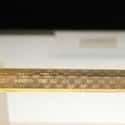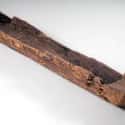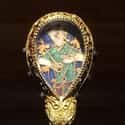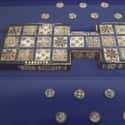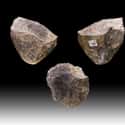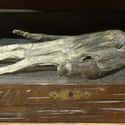-
(#1) Rosetta Stone
- Relief
This giant slab of basalt is where the Rosetta Stone language-learning program gets its name. Discovered by Napoleon Bonaparte's army in 1799, the slab contains a decree from King Ptolemy V (r. 204-181 BC) written in three different languages: Egyptian hieroglyphic, Egyptian Demotic (the "language of the people"), and ancient Greek (the language of Egypt's Greco-Macedonian rulers).
As the British Museum explains:
The importance of [the Rosetta Stone] to Egyptology is immense. When it was discovered, nobody knew how to read ancient Egyptian hieroglyphs. Because the inscriptions say the same thing in three different scripts, and scholars could still read Ancient Greek, the Rosetta Stone became a valuable key to deciphering the hieroglyphs.
-
(#2) The Antikythera Mechanism (c. 200-1 BC)
When it was first discovered at the beginning of the 20th century, the Antikythera Mechanism baffled archaeologists. It was a confusing muddle of modern-looking gears that had been resting at the bottom of the ocean for 2,000 years. Conspiracy theorists claimed it was evidence of a smashed alien vessel, while others thought it was a long-lost piece of Atlantean hardware. One investigator dubbed it an "ancient Greek computer," and time has proven that somewhat accurate.
It is now believed the mechanism was a kind of astronomical calculator. X-ray imaging and CT scans have revealed the device's interlocking gears were used to track the movement of the sun, moon, and planets visible to the naked eye. Inscriptions describe the dates when particular stars rise and set, and a dial on the back tracked lunar and solar eclipses.
-
(#3) King Tut's Meteorite Dagger (c. 14th Century BC)
King Tut's iron dagger was one of two blades hidden in the ancient pharaoh's mummified wrappings, along with another dagger made of gold. Interestingly, at the time of Tut's demise (c. 1323 BC), iron was actually more valuable than gold due to its rarity.
It is believed that most iron objects excavated from Egypt's Old Kingdom period were created from meteoric metal, or "iron from the sky." According to recent findings, the King Tut dagger's composition of iron, nickel, and cobalt "strongly suggests an extraterrestrial origin."
-
(#4) The Pyramidion Of The Black Pyramid Of Dashur (c. 1820 BC)
Pyramidions were created to be the capstones of ancient Egytpian pyramids, and few have survived into the present day. This pyramidion was found in the rubble near the Pyramid of Amenemhat III at Dashur, which is sometimes referred to as the Black Pyramid.
Not much remains of the Black Pyramid today, due to poor construction methods that doomed the structure from the beginning. The granite pryamidion, however, is in relatively good shape, and its four sides still bear legible inscriptions. It is currently housed in the Egyptian Museum at Cairo.
-
(#5) Babylonian Map Of The World (c. Sixth Century BC)
This clay tablet, dated to approximately 700 BC, depicts the world as a disc surrounded by a ring of water called the "Bitter River." Small circles indicate cities or districts, including Assyria and Der, and the rectangle on the right side of the Euphrates River is Babylon itself.
The British Museum has more information on the tablet, including details on the reverse side that describes eight regions beyond the known world, including the underworld.
-
(#6) Sword Of Goujian (c. 771-403 BC)
Despite being more than 2,500 years old, this Chinese dagger still retains a cutting edge. It was discovered in a tomb in Hubei, China, in 1965, and is believed to date back to the era between 771 and 403 BC. Forged from copper and tin, the blade also contains blue crystals and turquoise.
The Metropolitan Museum of Art notes that the eight characters engraved on the blade are an ancient writing called "bird-worm seal script," which reads, "King of Yue... made this sword for [his] personal use."
-
(#7) The Pesse Canoe (c. 8000 BC)
Believed to be the oldest-known boat in the world, and certainly the oldest canoe in the historical record, the Pesse canoe was discovered in Pesse, a village in the Dutch province of Drenthe, during the construction of a highway. The boat was carved out of a pine log roughly 10,000 years ago.
Carbon dating has placed the canoe's construction to the Mesolithic period, between 8040 BC and 7510 BC. A similar boat was discovered outside a village in Nigeria, dated some 2,000 years later.
-
(#8) The Voynich Manuscript (c. 15th Century AD)
Sometimes called "the world's most mysterious book," this 15th century codex is written in an unknown script by an unknown author. It gets its name from Wilfrid Voynich, who first came across it in 1912, but the book has popped up here and there over the centuries. A translation of the text, and the purpose of the book itself, eludes investigators to this day.
The manuscript contains "lively" illustrations that appear to encompass a number of scientific topics, from botanical species to astronomical charts to female biology. The origin of the manuscript remains a matter of debate, with some claiming the thing is just a hoax, and others saying it's the work of aliens.
-
(#9) The Alfred Jewel (c. Ninth Century AD)
Discovered in a field in Somerset, England, in 1693, this royal relic dates to the reign of King Alfred the Great (871-899 AD) and bears the inscription "AELFRED MEC HEHT GEWYRCAN," or "Alfred ordered me to be made."
According to the Ashmolean Museum, the jewel was originally part of an aestel, or pointer, a device used to follow text in manuscripts. A "significant" piece of Anglo-Saxon goldsmithing, the aestel was crafted around a slice of rock crystal.
-
(#10) British Museum Royal Game of Ur (c. 2600-2400 BC)
Popular throughout the Mediterranean and the Middle East thousands of years ago, the Royal Game of Ur was a popular pastime for ancient peoples.
As Irving Finkel, the assistant keeper at London's British Museum in the Department of the Middle East, explains, "There were no entertainments for such a huge period of human existence. In that environment, games had a fantastically strong hold. They reigned supreme."
Time sums it up even better: "For centuries, even millenniums, the Royal Game of Ur served as the PlayStation of its day."
-
(#11) Oldowan Choppers (c. 1.7 Million Years Ago)
They may look like ordinary rocks, but these things are considered the oldest stone tools in existence. Dating back 2.5 to 1.2 million years ago, Oldowan "chopper" tools were created by Homo habilis, an ancestor of Homo sapiens, and used for "cutting, chopping, and scraping" plants and animals.
The first of these tools were originally found in Olduvai Gorge in Tanzania, but other such artifacts have also been found in eastern, central, and southern Africa.
-
(#12) A Jade Cong From The Liangzhu Culture (c. 3300-2200 BC)
Living in China's Jiangsu province in the third millennium BC, the Neolithic Liangzhu culture created items out of jade, ceramic, and stone that still exist today. Many "cong" objects have been found, exhibiting a circular inner shape and square outer section, but their use and significance remain mysterious. Several cong have been unearthed in Chinese tombs from the period.
Khan Academy describes these objects as "among the most impressive yet most enigmatic of all ancient Chinese jade artifacts." Also, they "were extremely difficult and time-consuming to produce. As jade cannot be split like other stones, it must be worked with a hard abrasive sand."
-
(#13) The First Gutenberg Bible To Arrive In The United States (c. 15th Century)
One of the earliest mass-printed books, the Gutenberg Bible is a landmark in the history of humankind - and literacy in general. Of the 180 original Bibles, some 49 still exist today, 10 of which may be found in the United States.
The Bible pictured here, now on display at the New York Public Library, was bought by James Lenox in 1847. It was the first copy purchased by a US citizen.
-
(#14) The Whitby Museum's Hand Of Glory (c. 18th Century AD)
The Whitby Museum's Hand of Glory is not especially ancient, but it is a well-preserved example of an occult practice that dates back centuries (allegedly, it is also the only such hand to survive to the present day). The museum has a great, if gruesome, explanation of how these hands were purportedly used:
A Hand of Glory was supposedly the carefully prepared and "pickled" right hand of a felon, cut off while the body still hung from the gallows and used by burglars to send sleepers in a house into a [deep unconsciousness] from which they were unable to wake. In one version the clenched hand is used as a candleholder for a candle incorporating human fat, but in another (consistent with the Whitby hand) the outstretched hand has its own fingers lit. In this case should one of the fingers refuse to light it is a sign that someone in the household remains awake.
This hand was discovered in the early 1900s on the wall of a cottage in Castleton, England.
-
(#15) Shroud of Turin
Though its authenticity is a matter of fierce debate (and has been since it first emerged in the mid-14th century), the Shroud of Turin remains a powerful religious icon to many Christians the world over. Believed by some to be the burial shroud of Jesus Christ, the cloth has been studied extensively by scientists and religious scholars alike.
Today, the shroud is closely guarded behind bulletproof glass and seldom seen by the public. However, following the global turmoil of the COVID-19 pandemic, it was made available to view online in April 2020.
New Random Displays Display All By Ranking
About This Tool
While ancient times happened so long ago, some things never change. Over the years, archaeologists from all over the world have devoted themselves to excavating and exploring the history of human civilization. They have unearthed many valuable ancient cultural artifacts in a wide range, including tools, pottery, metal objects, personal items, etc. Cultural relics are relics and relics that reflect the material and spiritual culture of a nation.
The random tool shows 15 amazing artifacts from ancient times that reflect social development and social life from different aspects, and they are physical materials for studying the history of the ancient world.
Our data comes from Ranker, If you want to participate in the ranking of items displayed on this page, please click here.











